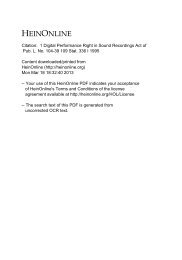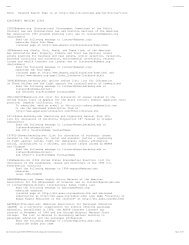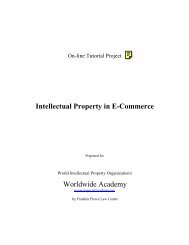BIEDERMANN MOTECH GMBH and Depuy Spine, Inc, Plaintiffs
BIEDERMANN MOTECH GMBH and Depuy Spine, Inc, Plaintiffs
BIEDERMANN MOTECH GMBH and Depuy Spine, Inc, Plaintiffs
You also want an ePaper? Increase the reach of your titles
YUMPU automatically turns print PDFs into web optimized ePapers that Google loves.
that the intention was to draft claim 1 broadly, introducing the rod slits 12-13 <strong>and</strong> 20-21 in dependent<br />
claims. The benefit of drafting claim 1 broadly <strong>and</strong> moving the slit limitations to dependent claims is that the<br />
patent would become stronger. A broader claim would allow the patent to be asserted against more<br />
competing products. Keeping the limitations in the dependent claims would provide assurance that if the<br />
broader claim were invalidated by a court, the dependent claims would remain. However, the attorney<br />
drafting the claims was apparently in a hurry, because he made at least one other obvious drafting error in<br />
claim 1 just four words later, referring to reference number "(16)" as "916)," i.e., he forgot to hit the shift<br />
key when typing the left parenthesis. It seems, therefore, that leaving the word "holes" in claim 1 was also a<br />
drafting error. (Order of Jan. 17, 2007, at 11.) Not only is the word unsupported by the specification, but<br />
putting the limitation of "holes" in claim 1 defeats the presumed purpose of expressing the limitation of<br />
"slits" in dependent claims. <strong>Plaintiffs</strong> insist, however, that "holes" is not a drafting error, <strong>and</strong> instead is<br />
intended to be read more broadly than "slits." (Pl. Resp. Br. at 7.) It is their prerogative to take that position.<br />
Therefore, "slits" will not be read equivalents to "holes." Novo Indus., L.P. v. Micro Molds Corp., 350 F.3d<br />
1348, 1357 (Fed.Cir.2003).<br />
The next question is what the word "holes" means. The word "hole" is not used anywhere in the patent<br />
specification, <strong>and</strong> so the intrinsic evidence is no help. At the time of the preliminary injunction, the evidence<br />
as to the word's meaning was rather meager, amounting to metaphors concerning Swiss cheese <strong>and</strong><br />
threadbare overcoats. (Order of Jan. 17, 2007, at 9-10.) The Court encouraged the parties to find more<br />
relevant extrinsic evidence, <strong>and</strong> commented that a meaning for "holes" which excluded the preferred<br />
embodiment would not be considered. Id. at 11. The parties have come back with satisfactory extrinsic<br />
evidence which essentially shows that the word "hole" has no specific meaning in the medical device field,<br />
<strong>and</strong> sometimes the word is used very broadly. (Pl. Op. Br. at 11-13; Allez Op. Br. at 12-13.) As Judge<br />
Harrington held, " 'holes' is a general term that includes 'slits.' " Biedermann Motech GmbH v. Alphatec<br />
<strong>Spine</strong>, <strong>Inc</strong>., 482 F.Supp.2d 32, 33 (D.Mass.2007). Having established that the term "holes" embraces the<br />
meaning of the word "slits" <strong>and</strong> is a term with a broader meaning, the next question is what the term "holes"<br />
actually means.<br />
<strong>Plaintiffs</strong> offer the definition, "openings, which may be U-shaped slits, in the receiver member that receive<br />
a rod." (Pl. Op. Br. at 25.) This definition seems adequate, so long as it is understood that this definition<br />
encompasses more than the term "slits." It would also be acceptable to instruct the jury that "holes" should<br />
be understood to have its ordinary meaning, with the underst<strong>and</strong>ing that "holes" means more than the word<br />
"slits" as used in claims 2 <strong>and</strong> 7. In the Medtronic litigation, the jury was not specially instructed on the<br />
meaning of the word "holes," <strong>and</strong> determined that the infringing product, which appears to have receiver<br />
member slits, met the limitation of "holes." (Pl. Reply Br. to Prelim. Inj. # 62, at 5.)<br />
The next question is how the claims should be interpreted, given that "holes" has been defined to mean<br />
something broader than "slits." Claim 2 depends from claim 1 <strong>and</strong> has a particular issue relating to the<br />
receiver member. The portion of claim 1 discussing the receiver member reads as follows:<br />
a receiver member (5) flexibly connected to said head (4), said receiver member being provided with two<br />
holes for receiving a rod [ (16) ], a receiver chamber (7) being provided within said receiver member (5),<br />
the receiver chamber (7) having at one end thereof a bore (8) for passing the threaded shaft portion (3)<br />
therethrough <strong>and</strong> an inner hollow spherically-shaped portion (9) for receiving the head (4) of said screw (1),<br />
an opening (10) being provided opposite said bore (8) for inserting said screw (1)<br />
('678 patent, cl. 1, at col. 4 ll. 12-21.) For this discussion, the key point is that the receiver member is






